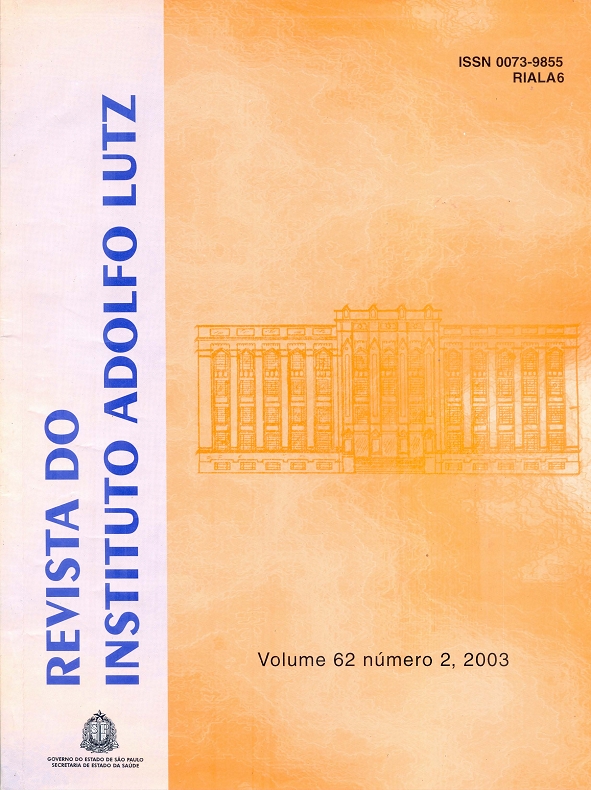Abstract
This study aims at measuring the dengue fever infection incidence in Paraíso City in the state of São Paulo due to an outbreak occurred in April, 1993. The serological survey showed an incidence of 3,7%, which indicates that aproximately 180 people could have been infected by the vírus during the outbreak. These data show that the symptomatic ratio is of 1:12, that is, for each case laboratorially diagnosed there were 11 without any diagnosis. A relationship between symptomatology and positive serology was found. Symptoms such as fever, headache and sore muscles were the most recalled ones. There was no statistically significant difference regarding age, sex, occupation and social-economical
level. It is also important to highlight that 33% of the positive individuals detected by the survey didn’t report any symptom.
References
1. Bravo,T.C. et al. Ecologia del Dengue y el Aedes aegypti. Investigación Preliminar. Salud Pública Méx., 26(suppl. 1): 63-76, 1984.
2. Fan,W.F. et al. The Reemergence of Dengue in China. Rev. Infect. Dis., 4: 847-53, 1989.
3. Figueiredo, L.T.M. et al. Encuesta Serológica sobre el Dengue en Ribeirão Preto, São Paulo, Brasil. Bol. Of. Sanit. Panam., 118(suppl. 6): 499 – 509, 1995.
4. Gubler, D. J. Vigiláncia Activa del Dengue y de la Fiebre Hemorragica del Dengue. Bol. of Sanit. Panam., 107(suppl. 1): 22 - 31. 1989a.
5. Gubler,D.J.; Costa-Valez, A. A Program for Prevention and Control Epidemic Dengue and Dengue Hemorragic Fever in Puerto Rico and the U.S.Virgian Islands. Bull. PAHO, 25(suppl. 3): 237-47, 1991.
6. Guzman, M. G. et al. Dengue Hemorragic Fever in Cuba I. Serological Confirmation and Clinical Diagnosis. Trans. R. Soc. Trop. Med. Hyg., 78(suppl. 2): 235-8, 1984.
7. Guzman, M. G. et al. Dengue en Cuba : Historia de una epidemia. Rev. Cubana Med. Trop., 40(suppl. 2): 29-49, 1988.
8. Kouri, G. et al. Dengue hemorragico en Cuba. Cronica de una epidemia. Bol. Of. Sanit. Pan., 100: 322-8, 1986.
9. Kuno, G.; Gomez, I.; Gubler, D.J. Detecting artificial antidengue IgM immune complexes using an enzyme-linked immunosorbent assay. Am. J. Trop. Med. Hyg., 36: 153 -59, 1987.
10. Monath, T. P.; Heinz, F.X. Flaviviruses. 3rd. ed. Philadelphia, Lippincott - Raven Publishers, 1996. p.961-1054: Fields Virology.
11. Organização Mundial da Saúde. Dengue Hemorrágico: Diagnóstico, Tratamento e Controle. Genebra, 1987.
12. Organizacion Mundial de la Salud. Encuestas Serológicas múltiples y Bancos de la OMS para Sueros de Referência, 454: 104 , 1970. (Série de Informes Técnicos).
13. Organização Panamericana de la Salud. Resurgimento del dengue en las Américas. Boletín Epidemiológico, 18(suppl. 2), 1997.
14. Orenstein, W. A , et al. Field Evaluation of Vaccine Efficacy. Bull. W.H.O , 639(suppl. 6): 1055 - 68, 1985.
15. Qiu, F. X. et al. The First Epidemic of Dengue Hemorragic Fever in the Peoples Republic of China. Am. J. Trop. Med. Hyg., 44(suppl. 4): 364 - 70, 1991.
16. Secretaria de Estado da Saúde. Centro de Vigilância Epidemiológica. Manual de Vigilância Epidemiológica do dengue. São Paulo, 1987a.
17. Shope, R. E. The use of micro – hemagglutination - inhibition test to follow antibody response after arthropod – borne virus infection in a community of forest animals. An. Microbiol., 11: 167-71, 1983.
18. Vasconcelos, P.F.C. et al. Epidemia de Febre Clássica de Dengue causada pelo sorotipo 2 em Araguaina, Tocantins, Brasil. Rev. Inst. Med. Trop. São Paulo, 35(suppl. 2): 141-48, 1993.

This work is licensed under a Creative Commons Attribution 4.0 International License.
Copyright (c) 2003 Revista do Instituto Adolfo Lutz
